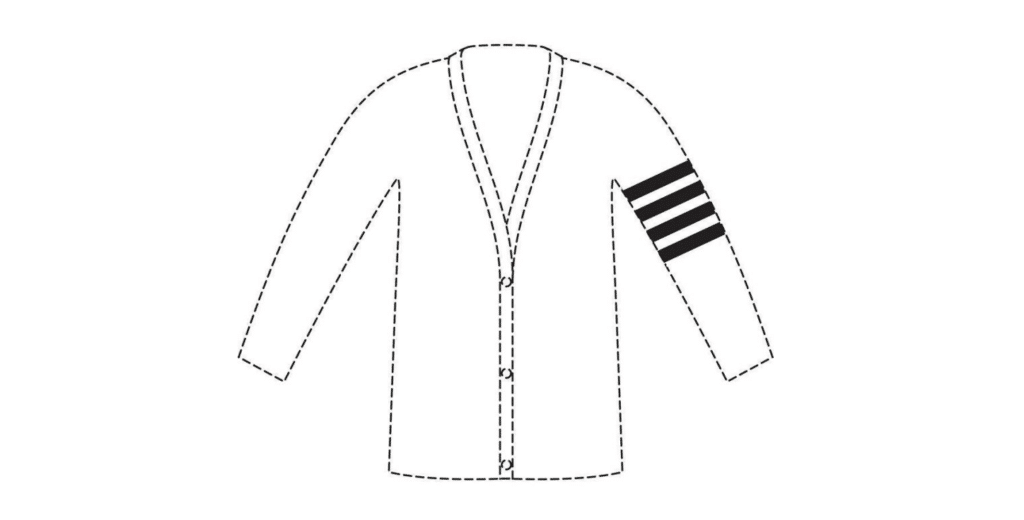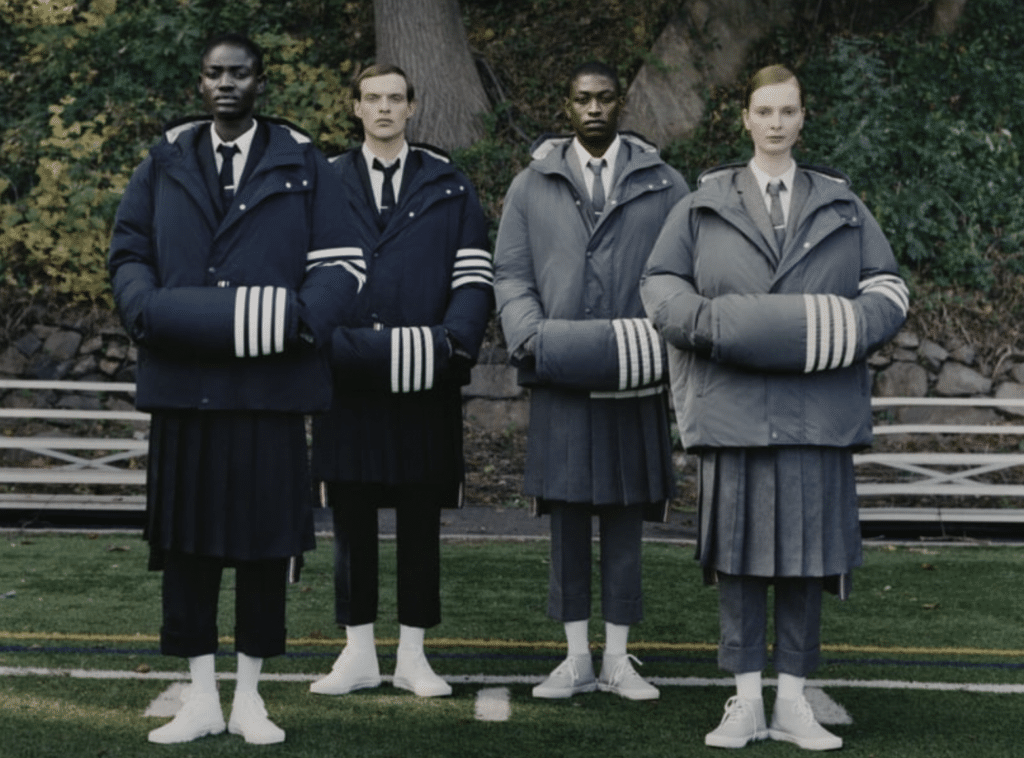Thom Browne has been handed a loss in a bid to register an iteration of its four-stripe trademark. In a decision issued on March 25, the European Union Intellectual Property Office (“EUIPO”) rejected an application by Thom Browne, Inc. to register a position trademark consisting of four horizontal white stripes placed on the upper left sleeve of garments. The refusal – based on Article 7(1)(b) of the EU Trademark Regulation (“EUTMR”) – signals the continued challenge that companies face in securing protection for design elements that could be deemed decorative.
The Background in Brief: Thom Browne lodged an application for registration with the EUIPO in March 2024, looking to nab a registration for a four-stripe position mark for use on a range of clothing items, including shirts, pullovers, hoodies, jackets, dresses, etc.
A Decorative Detail, Not a Distinctive Mark
In assessing the mark, the EUIPO concluded that the relevant consumer would perceive Thom Browne’s mark as a purely decorative feature of the goods upon which it appears – rather than as an identifier of source. According to its decision, the trademark body held that “the placement of the element and its appearance do not significantly differ from the usual practices in the relevant sector.” The Office emphasized that while consumers may be accustomed to identifying word or figurative marks as trademarks, this is not necessarily the case with position marks. In this instance, the EUIPO determined that the four evenly spaced horizontal stripes are a common design element within the fashion industry and are not likely to be recognized as indicating commercial origin.

Thom Browne’s legal team argued that the four-bar motif possesses at least a minimum degree of distinctiveness, noting that a simple internet search for “four bars shirts” yields a large number of results showing Thom Browne’s designs. The EUIPO dismissed this argument, stating that the search results are not determinative, and that many of the listings at issue came from third-party sellers or featured unrelated products, undermining any claim of exclusivity in the striped mark.
Citing EUIPO case law, the trademark body confirmed that simple geometric shapes – such as lines, circles, and rectangles – lack inherent distinctiveness. In the absence of evidence demonstrating acquired distinctiveness, and without invoking Article 7(3) EUTMR, the Office concluded that Thom Browne’s four-bar sleeve design cannot function as a trademark.
Additionally, the Office pointed out that Browne did not invoke Article 7(3) EUTMR—an option that allows applicants to submit evidence that a non-distinctive sign has gained distinctiveness through extensive use. Without this evidentiary effort, the Office held that there was no basis to conclude that consumers in the EU associate the four-stripe motif with Thom Browne.
An Unsurprising Outcome
The EUIPO’s decision is consistent with a well-established line of rulings from both the trademark office and the EU courts, which have repeatedly held that simple or minimalist signs – particularly in the fashion industry – often lack the inherent distinctiveness required for trademark protection. In a decision in 2019, for instance, the EU’s General Court held that adidas failed to provide sufficient and consistent evidence of use across all EU Member States to prove acquired distinctiveness of one of its three-stripe marks. The ruling made clear that such geometric designs, even when widely associated with a brand, cannot be protected unless consumers across the EU recognize the sign as a trademark, not just as decoration.
Not long thereafter, the General Court held that an iteration of Louis Vuitton’s checkerboard pattern lacks inherent distinctiveness and that the luxury goods brand failed to demonstrate that the mark had acquired a distinctive character through use.
In the case at hand, the EUIPO cited numerous similar refusals for position marks involving simple stripe motifs on garments. These included refusals of applications for two and three parallel lines placed on sleeves or pant legs, which the Office found indistinguishable from commonplace decorative elements in apparel design. Specifically, the decision referenced Cases R 2560/2013-5, R 1232/2017-2, and T-64/15, where even slightly stylized stripe motifs were held to lack distinctiveness in the absence of acquired distinctiveness through use (Article 7(3) EUTMR).
The cumulative effect of these cases reinforces the position that basic geometric or linear design elements – even when systematically used by a brand – are likely to be presumed to be non-distinctive unless the applicant can prove, with robust and geographically broad evidence, that consumers perceive them as an indicator of commercial origin.
THE TAKEAWAY FOR BRANDS: The ruling serves as a reminder that brands seeking to protect subtle visual signatures – such as stripes, shapes, or design placements – must be prepared to prove their distinctiveness, especially when filing as position marks. Mere use in commerce, or even widespread online visibility, is not enough. Trademark protection in the EU demands that applicants go beyond aesthetics and show that consumers recognize the design as a trademark.
Thom Browne has the right to appeal the decision within two months, and to submit further evidence of acquired distinctiveness within four months.













